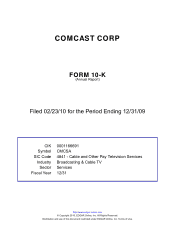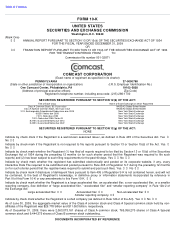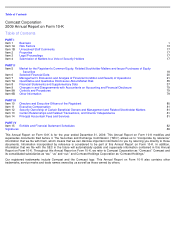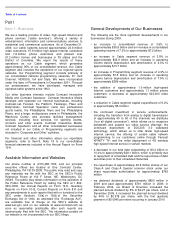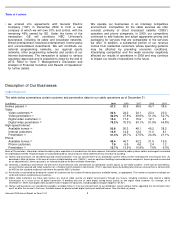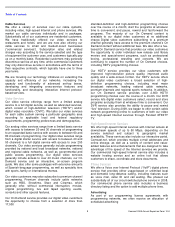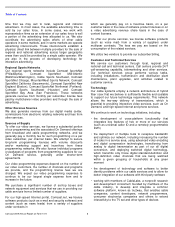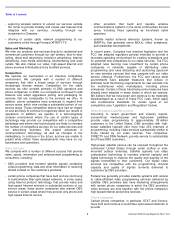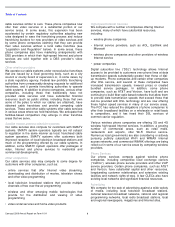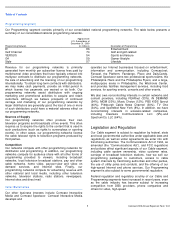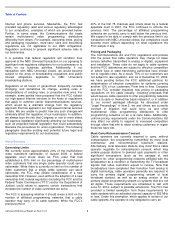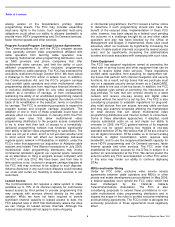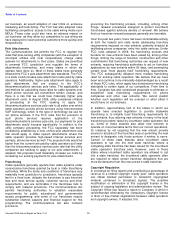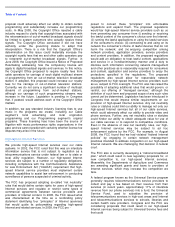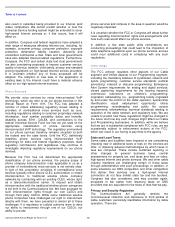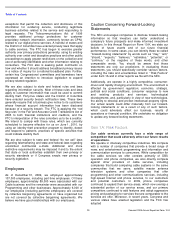Comcast 2009 Annual Report Download - page 9
Download and view the complete annual report
Please find page 9 of the 2009 Comcast annual report below. You can navigate through the pages in the report by either clicking on the pages listed below, or by using the keyword search tool below to find specific information within the annual report.
Table of Contents
Comcast 2009 Annual Report on Form 10-K
4
time that we may sell to local, regional and national
advertisers. In most cases, the available advertising time is
sold by our sales force. In some cases, we work with
representation firms as an extension of our sales force to sell
a portion of the advertising time allocated to us. We also
coordinate the advertising sales efforts of other cable
operators in some markets, and in some markets we operate
advertising interconnects. These interconnects establish a
physical, direct link between multiple providers for the sale of
regional and national advertising across larger geographic
areas than could be provided by a single cable operator. We
are also in the process of developing technology for
interactive advertising.
Regional Sports Networks
Our regional sports networks include Comcast SportsNet
(Philadelphia), Comcast SportsNet Mid-Atlantic
(Baltimore/Washington), Cable Sports Southeast, Comcast
SportsNet Chicago, MountainWest Sports Network, Comcast
SportsNet California (Sacramento), Comcast SportsNet New
England (Boston), Comcast SportsNet Northwest (Portland),
Comcast Sports Southwest (Houston) and Comcast
SportsNet Bay Area (San Francisco). These networks
generate revenue from monthly per subscriber license fees
paid by multichannel video providers and through the sale of
advertising.
Other Revenue Sources
We also generate revenue from our digital media center,
commissions from electronic retailing networks and fees from
other services.
Sources of Supply
To offer our video services, we license a substantial portion
of our programming and the associated On Demand offerings
from broadcast and cable programming networks, and we
generally pay a monthly fee for such programming on a per
video subscriber, per channel basis. We attempt to secure
long-term programming licenses with volume discounts
and/or marketing support and incentives from these
programming networks. We also license individual programs
or packages of programs from programming suppliers for our
On Demand service, generally under shorter-term
agreements.
Our video programming expenses depend on the number of
our video customers, the number of channels and programs
we provide, and the programming license fees we are
charged. We expect our video programming expenses to
continue to be our largest single expense item and to
increase in the future.
We purchase a significant number of set-top boxes and
network equipment and services that we use in providing our
cable services from a limited number of suppliers.
For our high-speed Internet portal, Comcast.net, we license
software products (such as e-mail and security software) and
content (such as news feeds) from a variety of suppliers
under contracts in
which we generally pay on a fixed
-fee basis, on a per
customer basis in the case of software product licenses or on
a video advertising revenue share basis in the case of
content licenses.
To offer our phone services, we license software products
(such as voice mail) from a variety of suppliers under
multiyear contracts. The fees we pay are based on the
consumption of the related services.
We utilize two vendors to provide our subscriber billing.
Customer and Technical Services
We service our customers through local, regional and
national call and technical centers. Call centers provide 24/7
call-answering capability, telemarketing and other services.
Our technical services group performs various tasks,
including installations, transmission and distribution plant
maintenance, plant upgrades, and activities related to
customer service.
Technology
Our cable systems employ a network architecture of hybrid
fiber coax that we believe is sufficiently flexible and scalable
to support our future technology requirements. This network
allows the two-way delivery of transmissions, which is
essential to providing interactive video services, such as On
Demand, and high-speed Internet and phone services.
We continue to work on technology initiatives, including:
•
the development of cross-
platform functionality that
integrates key features of two or more of our services
(such as universal caller ID and a remotely programmable
DVR)
•
the deployment of multiple tools to recapture bandwidth
and optimize our network, including increasing the number
of nodes in a service area, using advanced video encoding
and digital compression technologies, transitioning from
analog to digital transmission as part of our all digital
conversion, and deploying switched digital technology,
which transmits only those digital standard
-
definition and
high-
definition video channels that are being watched
within a given grouping of households at any given
moment
•
the development of technology and software to better
identify problems within our cable services and to allow for
better integration of our software with third party software
•
working with members of CableLabs, a nonprofit research
and development consortium founded by members of the
cable industry, to develop and integrate a common
software platform, known as tru2way, that enables cable
companies, content developers, network programmers,
consumer electronics companies and others to extend
interactivity to the TV set and other types of devices

